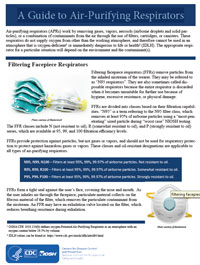
Air-purifying respirators (APRs) work by removing gases, vapors, aerosols (airborne droplets and solid particles), or a combination of contaminants from the air through the use of filters, cartridges, or canisters. These respirators do not supply oxygen from other than the working atmosphere, and therefore cannot be used in an atmosphere that is oxygen-deficient or immediately dangerous to life or health (IDLH). The appropriate respirator for a particular situation will depend on the environment and the contaminant(s).
Source
NIOSH [2018]. A Guide to Air-Purifying Respirators. By Cichowicz J, Coffey C, Fries M. Pittsburgh, PA: U.S. Department of Health and Human Services, Centers for Disease Control and Prevention, National Institute for Occupational Safety and Health, DHHS (NIOSH) Publication No. 2018-176, https://doi.org/10.26616/NIOSHPUB2018176
